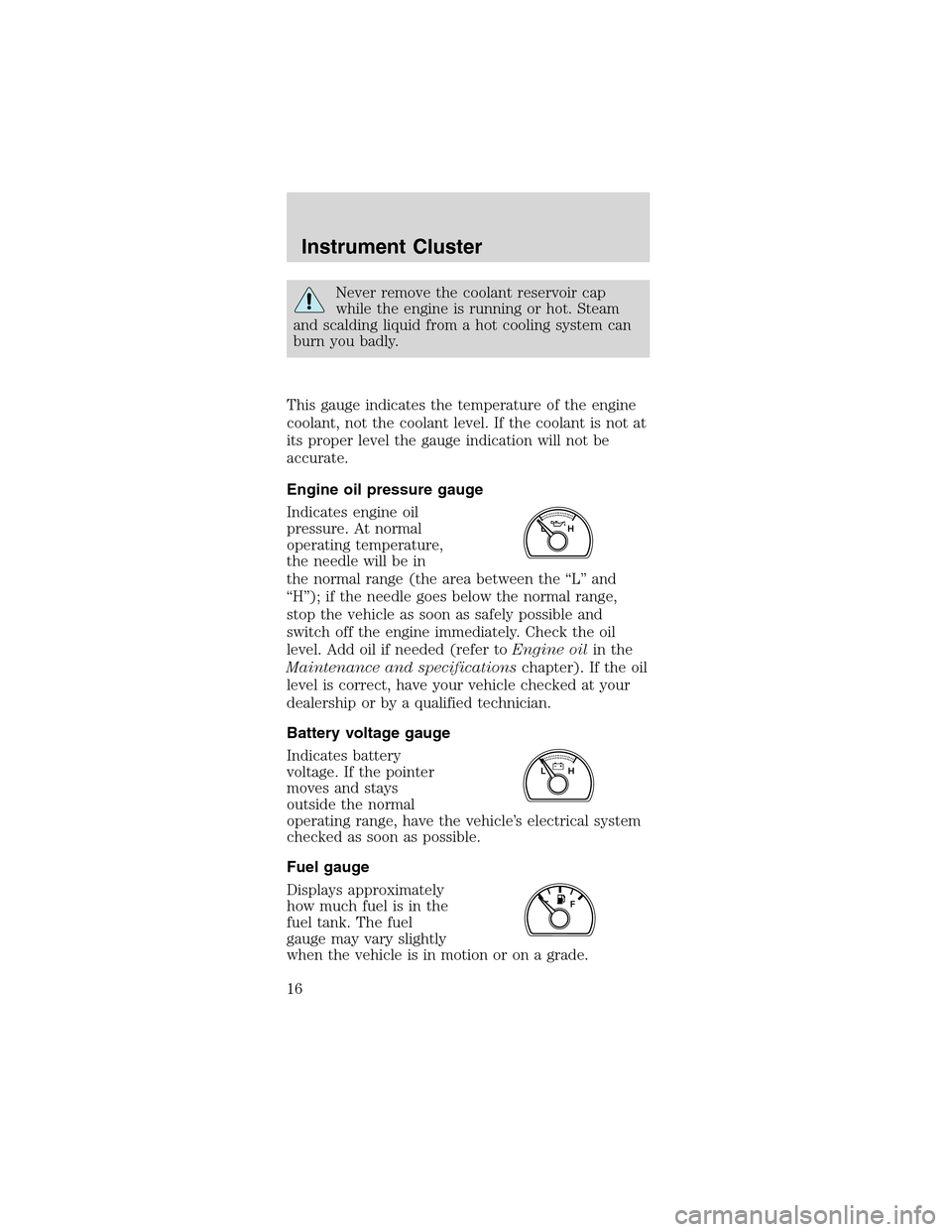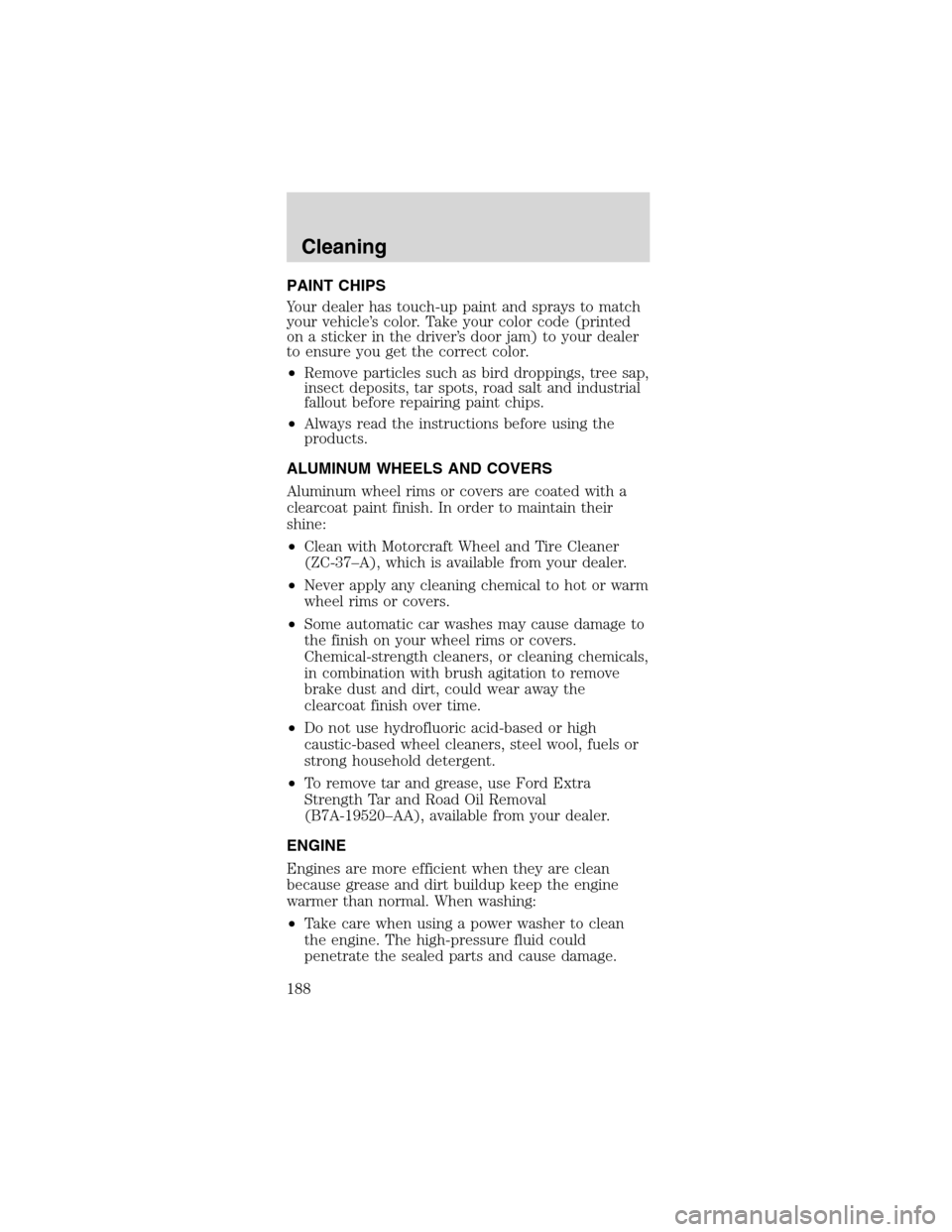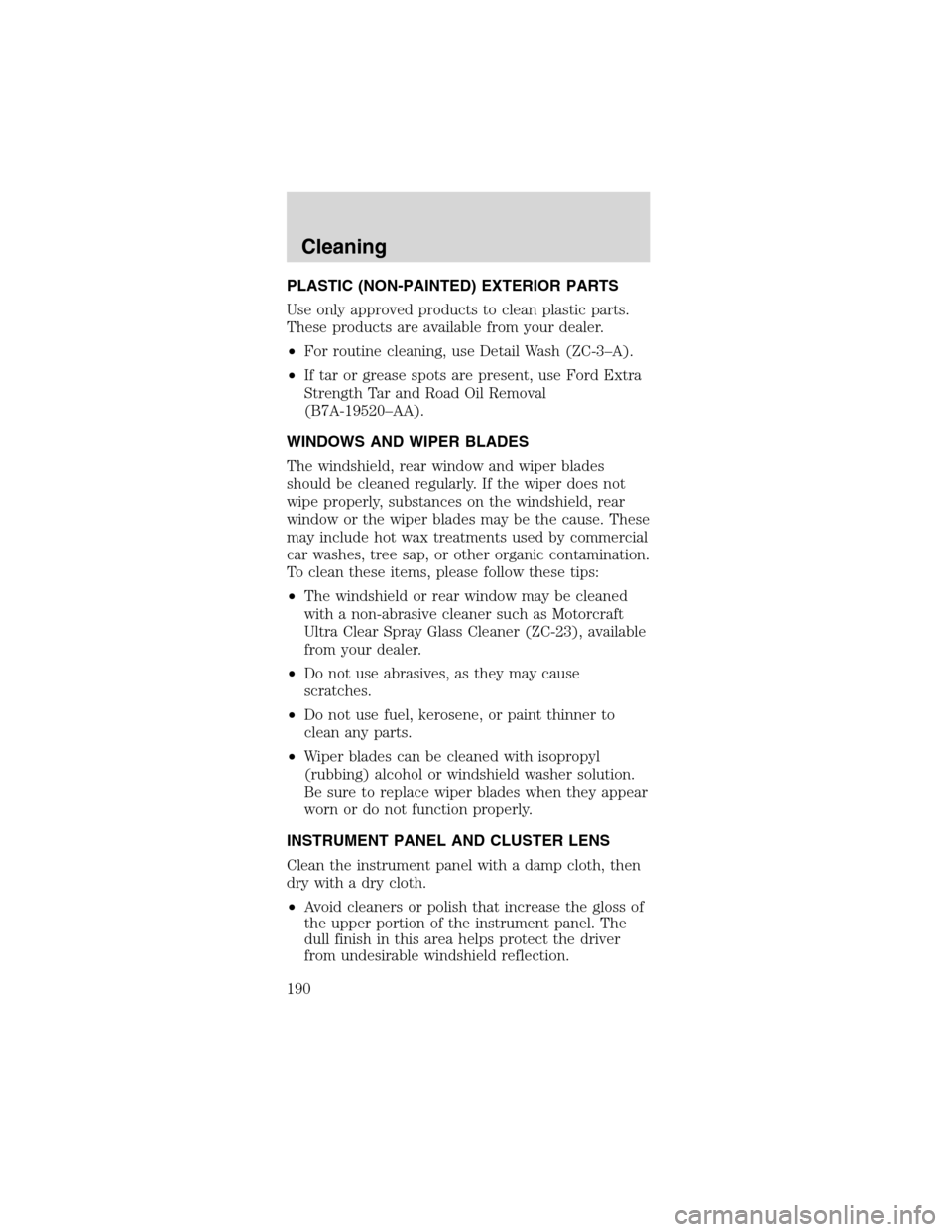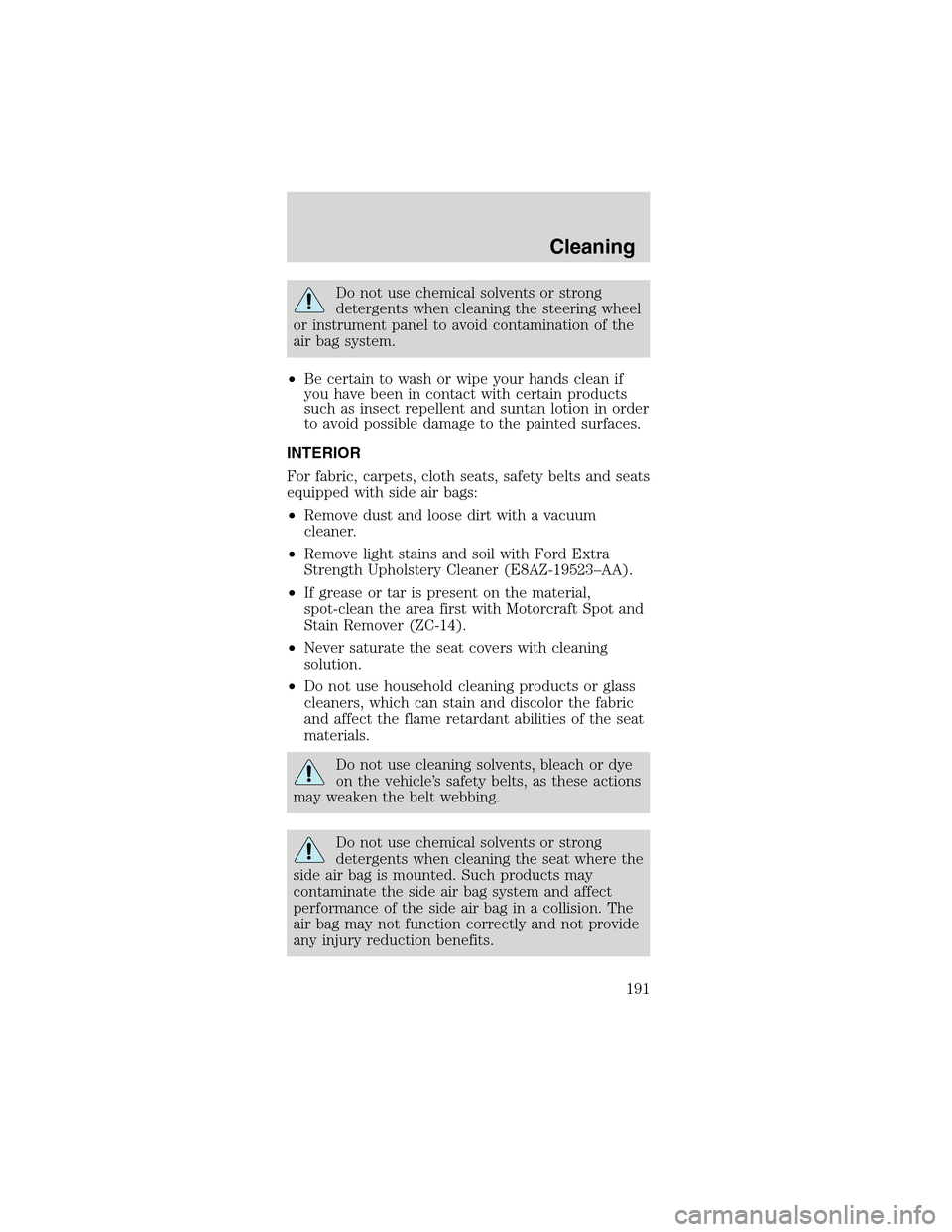Page 2 of 256
Brakes 138
Traction control/AdvanceTrac 142
Transmission operation 144
Vehicle loading 154
Trailer towing 156
Roadside Emergencies 157
Getting roadside assistance 157
Hazard flasher switch 158
Fuel pump shut-off switch 159
Fuses and relays 160
Changing tires 165
Jump starting 170
Wrecker towing 175
Customer Assistance 176
Reporting safety defects (U.S. only) 186
Cleaning 187
Maintenance and Specifications 194
Engine compartment 197
Engine oil 199
Battery 203
Fuel information 214
Part numbers 237
Refill capacities 238
Lubricant specifications 240
Accessories 245
Index 248
All rights reserved. Reproduction by any means, electronic or
mechanical including photocopying, recording or by any
information storage and retrieval system or translation in
whole or part is not permitted without written authorization
from Ford Motor Company. Ford may change the contents
without notice and without incurring obligation.
Copyright © 2002 Ford Motor Company
Table of Contents
2
Page 9 of 256
Vehicle Symbol Glossary
Interior Luggage
Compartment
Release Symbol
Panic Alarm
Engine OilEngine Coolant
Engine Coolant
TemperatureDo Not Open When
Hot
BatteryAvoid Smoking,
Flames, or Sparks
Battery AcidExplosive Gas
Fan WarningPower Steering
Fluid
Maintain Correct
Fluid LevelMAX
MINEmission System
Engine Air FilterPassenger
Compartment Air
Filter
JackCheck fuel cap
Low tire warning
Introduction
9
Page 16 of 256

Never remove the coolant reservoir cap
while the engine is running or hot. Steam
and scalding liquid from a hot cooling system can
burn you badly.
This gauge indicates the temperature of the engine
coolant, not the coolant level. If the coolant is not at
its proper level the gauge indication will not be
accurate.
Engine oil pressure gauge
Indicates engine oil
pressure. At normal
operating temperature,
the needle will be in
the normal range (the area between the“L”and
“H”); if the needle goes below the normal range,
stop the vehicle as soon as safely possible and
switch off the engine immediately. Check the oil
level. Add oil if needed (refer toEngine oilin the
Maintenance and specificationschapter). If the oil
level is correct, have your vehicle checked at your
dealership or by a qualified technician.
Battery voltage gauge
Indicates battery
voltage. If the pointer
moves and stays
outside the normal
operating range, have the vehicle’s electrical system
checked as soon as possible.
Fuel gauge
Displays approximately
how much fuel is in the
fuel tank. The fuel
gauge may vary slightly
when the vehicle is in motion or on a grade.
LH
LH
F
Instrument Cluster
16
Page 73 of 256

6. Without turning,
remove the old bulb
from the lamp assembly
by gently pulling it
straight out of the lamp
assembly.
To install the new bulb:
Handle a halogen headlamp bulb carefully
and keep out of children’s reach. Grasp the
bulb only by its plastic base and do not touch the
glass. The oil from your hand could cause the bulb
to break the next time the headlamps are
operated.
1. With the flat side of the new bulb’s plastic base
facing upward, insert the glass end of the bulb into
the lamp assembly. You may need to turn the bulb
left or right to align the grooves in the plastic base
with the tabs in the lamp assembly. When the
grooves are aligned, push the bulb into the lamp
assembly until the plastic base contacts the rear of
the lamp assembly.
2. Install the bulb retaining ring over the plastic base
until it contacts the rear of the socket by rotating
clockwise until you feel a“stop.”
3. Connect the electrical connector into the plastic
base until it snaps, locking it into position.
4. Install the headlamp on vehicle by aligning the
lamp with the rear snap retainers, push to seat and
secure with two retainer pins.
5. Turn the headlamps on and make sure they work
properly. If the headlamp was correctly aligned
before you changed the bulb, you should not need to
align it again.
Replacing front parking lamp/turn signal bulbs
1. Make sure the headlamp control is in the OFF
position.
2. Open the hood.
Lights
73
Page 188 of 256

PAINT CHIPS
Your dealer has touch-up paint and sprays to match
your vehicle’s color. Take your color code (printed
on a sticker in the driver’s door jam) to your dealer
to ensure you get the correct color.
•Remove particles such as bird droppings, tree sap,
insect deposits, tar spots, road salt and industrial
fallout before repairing paint chips.
•Always read the instructions before using the
products.
ALUMINUM WHEELS AND COVERS
Aluminum wheel rims or covers are coated with a
clearcoat paint finish. In order to maintain their
shine:
•Clean with Motorcraft Wheel and Tire Cleaner
(ZC-37–A), which is available from your dealer.
•Never apply any cleaning chemical to hot or warm
wheel rims or covers.
•Some automatic car washes may cause damage to
the finish on your wheel rims or covers.
Chemical-strength cleaners, or cleaning chemicals,
in combination with brush agitation to remove
brake dust and dirt, could wear away the
clearcoat finish over time.
•Do not use hydrofluoric acid-based or high
caustic-based wheel cleaners, steel wool, fuels or
strong household detergent.
•To remove tar and grease, use Ford Extra
Strength Tar and Road Oil Removal
(B7A-19520–AA), available from your dealer.
ENGINE
Engines are more efficient when they are clean
because grease and dirt buildup keep the engine
warmer than normal. When washing:
•Take care when using a power washer to clean
the engine. The high-pressure fluid could
penetrate the sealed parts and cause damage.
Cleaning
188
Page 190 of 256

PLASTIC (NON-PAINTED) EXTERIOR PARTS
Use only approved products to clean plastic parts.
These products are available from your dealer.
•For routine cleaning, use Detail Wash (ZC-3–A).
•If tar or grease spots are present, use Ford Extra
Strength Tar and Road Oil Removal
(B7A-19520–AA).
WINDOWS AND WIPER BLADES
The windshield, rear window and wiper blades
should be cleaned regularly. If the wiper does not
wipe properly, substances on the windshield, rear
window or the wiper blades may be the cause. These
may include hot wax treatments used by commercial
car washes, tree sap, or other organic contamination.
To clean these items, please follow these tips:
•The windshield or rear window may be cleaned
with a non-abrasive cleaner such as Motorcraft
Ultra Clear Spray Glass Cleaner (ZC-23), available
from your dealer.
•Do not use abrasives, as they may cause
scratches.
•Do not use fuel, kerosene, or paint thinner to
clean any parts.
•Wiper blades can be cleaned with isopropyl
(rubbing) alcohol or windshield washer solution.
Be sure to replace wiper blades when they appear
worn or do not function properly.
INSTRUMENT PANEL AND CLUSTER LENS
Clean the instrument panel with a damp cloth, then
dry with a dry cloth.
•Avoid cleaners or polish that increase the gloss of
the upper portion of the instrument panel. The
dull finish in this area helps protect the driver
from undesirable windshield reflection.
Cleaning
190
Page 191 of 256

Do not use chemical solvents or strong
detergents when cleaning the steering wheel
or instrument panel to avoid contamination of the
air bag system.
•Be certain to wash or wipe your hands clean if
you have been in contact with certain products
such as insect repellent and suntan lotion in order
to avoid possible damage to the painted surfaces.
INTERIOR
For fabric, carpets, cloth seats, safety belts and seats
equipped with side air bags:
•Remove dust and loose dirt with a vacuum
cleaner.
•Remove light stains and soil with Ford Extra
Strength Upholstery Cleaner (E8AZ-19523–AA).
•If grease or tar is present on the material,
spot-clean the area first with Motorcraft Spot and
Stain Remover (ZC-14).
•Never saturate the seat covers with cleaning
solution.
•Do not use household cleaning products or glass
cleaners, which can stain and discolor the fabric
and affect the flame retardant abilities of the seat
materials.
Do not use cleaning solvents, bleach or dye
on the vehicle’s safety belts, as these actions
may weaken the belt webbing.
Do not use chemical solvents or strong
detergents when cleaning the seat where the
side air bag is mounted. Such products may
contaminate the side air bag system and affect
performance of the side air bag in a collision. The
air bag may not function correctly and not provide
any injury reduction benefits.
Cleaning
191
Page 192 of 256

LEATHER SEATS (IF EQUIPPED)
Your leather seating surfaces have a clear, protective
coating over the leather.
•To clean, use a soft cloth with Motorcraft Deluxe
Leather and Vinyl Cleaner (ZC-11–A). Dry the
area with a soft cloth.
•To help maintain its resiliency and color, use the
Motorcraft Deluxe Leather Care Kit (ZC-11–D),
available from your authorized dealer.
•Do not use household cleaning products, alcohol
solutions, solvents or cleaners intended for
rubber, vinyl and plastics, or oil/petroleum-based
leather conditioners. These products may cause
premature wearing of the clear, protective
coating.
CONVERTIBLE TOP AND PADDED MOLDING
Wash with Motorcraft Triple Clean (ZC-13), which is
available from your dealer.
•Do not use stiff bristle brushes or abrasive
materials or cleaners.
•Hot waxes applied by commercial car washes can
affect the cleanability of vinyl material.
•Using high water pressure or wand-type car
washes against the convertible top and windows
may cause water leaks and possible seal damage.
UNDERBODY
Flush the complete underside of your vehicle
frequently. Keep body and door drain holes free
from packed dirt.
FORD, LINCOLN AND MERCURY CAR CARE
PRODUCTS
Your Ford, Lincoln or Mercury dealer has many
quality products available to clean your vehicle and
protect its finishes. These quality products have
been specifically engineered to fulfill your
automotive needs; they are custom designed to
Cleaning
192